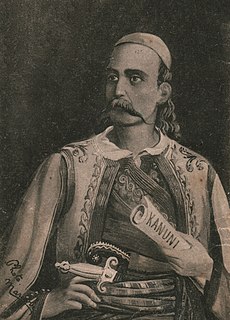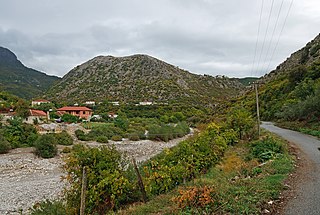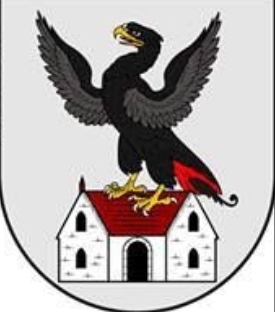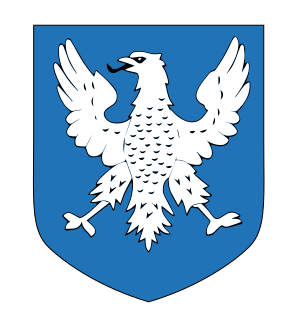Related Research Articles

Lekë III Dukagjini (1410–1481), mostly known as Lekë Dukagjini, was a member of the Dukagjini family a 15th-century Albanian nobleman. A contemporary of Skanderbeg, Dukagjini is known for the Kanuni i Lekë Dukagjinit, a code of law instituted among the tribes of northern Albania.

The Albanian–Venetian War of 1447–48 was waged between Venetian and Ottoman forces against the Albanians under George Kastrioti Skanderbeg. The war was the result of a dispute between the Republic and the Dukagjini family over the possession of the Dagnum fortress. Skanderbeg, then ally of the Dukagjini family, moved against several Venetian held towns along the Albanian coastline, in order to pressure the Venetians into restoring Dagnum. In response, the Republic sent a local force to relieve the besieged fortress of Dagnum, and urged the Ottoman Empire to send an expeditionary force into Albania. At that time the Ottomans were already besieging the fortress of Svetigrad, stretching Skanderbeg's efforts thin.

Dagnum was a town, bishopric and important medieval fortress located on the territory of present-day Albania, which has been under Serbian, Venetian and Ottoman control and remains a Latin Catholic titular see. It is close to the modern day town of Vau i Dejës.

Drisht is a village, former bishopric and Latin titular see with an Ancient and notable medieval history in Albania, 6 km from Mes Bridge. It is located in the former municipality Postribë in the Shkodër County. At the 2015 local government reform it became part of the municipality Shkodër. The ruined 13th Century Drisht Castle is on a hilltop 800m above sea level. The ruins of the castle itself contains the remains of 11 houses, and below the ruins of the castle, and above the modern village of Drisht are further archeological remains of late-Roman and medieval Drivastum.

The Zaharia family was an Albanian noble family that appears for the first time mentioned in the 14th century. A certain Nicholas Zaharia is first mentioned in 1385 as a Balšić family commander and governor of Budva in 1363. After more than twenty years of fidelity, Nicholas Zaharia revolted in 1386 and became ruler of Budva. However, in 1389 Đurađ II Balšić recaptured the city.

The Dukagjini were an Albanian feudal noble family. They may have been relatives or descendants of the earlier Progoni, who founded the first Albanian state in recorded history, the Principality of Arbanon. Their domain extended from northern Albania to western Kosovo. The city of Lezhë was its most important holding.
Koja Zaharia or Koja Zakaria was an Albanian nobleman and a member of the Zaharia family.
Lekë Zaharia, was an Albanian nobleman from Zaharia family. He was the only son of his father Koja Zaharia and mother Bosa who also had one daughter, Bolja, who named her son Koja after her father.
Georgius Pelino was a Catholic priest, the abbot of Ratac Abbey and diplomat of Skanderbeg and Venetian Republic.

The Spani was a northern Albanian noble family and clan. The center of the family was Drivast, which it ruled holding the titles of Duke and Count. In the late 15th century, a large part of it settled in Venetian territories, primarily Venice itself and Dalmatia. Members of this family lived in a wider region ranging from northern Albania and Montenegro to western Kosovo.

Baleč was an medieval fortified town near Shkodër in what is now Albania. It was built on the hill whose name was Balez. The settlement originated in Roman times. During Byzantine rule over the area, it was part of the Dyrrhachium theme. Later it was a seat of a župa of the Kingdom of Duklja, and later still of the Lordship of Zeta. Baleč suffered much damage during the Second Scutari War between the Serbian Despotate and the Republic of Venice. After the Republic of Venice gained control over it at the beginning of the 15th century, its size was reduced to a small pronoia with only 25 houses, and the fortress was abandoned and fell to ruin. Skanderbeg's forces rebuilt the fortress during his war with Venice in 1448 and established a strong garrison in it, but the Venetian forces soon drove them away and demolished the fortress. Ottoman plans to rebuild Baleč and populate it with Turkish settlers were never implemented and Baleč remained in ruins, which can still be seen today.

Sati was a medieval fortified town near Shkodër in contemporary Albania. Between 1395 and 1459, it passed through the control of the Venetian Republic, the Dukagjini family, the Ottoman Empire, and Skanderbeg, who razed it sometime after 1459.
Pal Dukagjini was an Albanian nobleman, a member of the Dukagjini family. He and his kinsman Nicholas Dukagjini were initially subjects of Lekë Zaharia, a Venetian vassal who had possessions around Shkoder. Nicholas murdered Lekë, and the Dukagjini continued to rule over their villages under Venetian vassalage. Pal and Nicholas were part of the League of Lezhë, a military alliance that sought liberation of Albania from the Ottoman Empire, founded by the powerful Skanderbeg. In 1454, the Dukagjini accepted vassalage of Alfonso V of Aragon, as other chieftains had done three years earlier. Pal later abandoned Skanderbeg's army and deserted to the Ottomans.
Nicholas Dukagjin was a 15th-century member of the Dukagjini family.
Peter Spani was a Catholic Albanian nobleman and Venetian pronoier in the first half of the 15th century. His family's domains included territories around Shkodër (Scutari), Drisht (Drivasto) and western Kosovo. He ruled over Shala, Shosh, Nikaj-Mërtur (Lekbibaj) and Pult; the whole region under the Ottomans took his name, Petrişpan-ili. Between 1444 and 1455, Peter was a member of the League of Lezhë and after his death, the League took his territories.
Triadan Gritti was a 15th-century Venetian nobleman who was the Venetian captain general and commander-in-chief of Scutari.
This timeline lists important events relevant to the life of George Kastrioti Skanderbeg, widely known as Skanderbeg.
The Moneta family was a 15th-century noble family of Zeta, Serbian Despotate and Venetian Republic in the region of Scutari. They first served Zeta's Lord Balša III and Serbian despot Stefan Lazarević before they became pronoiars of the Venetian Republic in 1423. Their religion was Eastern Orthodox and they ruled the land between rivers Bojana and Drin. The most notable members of the Moneta family include Rajko Moneta, his wife Jelena and their three sons. First Rajko and then his sons participated in numerous military conflicts including the Second Scutari War, the Albanian–Venetian War (1447–1448) and the Ottoman sieges of Scutari, first in 1474 and then 1478/1479. After Scutari was captured by the Ottomans in 1479 Nicholas, one of the sons who became voivode of Scutari, went to Venice to join his wife and their five children who took refuge in Venice in 1478 before the last Ottoman siege of Scutari started.

Skanderbeg's rebellion was an almost 25-year long anti-Ottoman rebellion led by the renegade Ottoman sanjakbey Skanderbeg in the territory which belonged to the Ottoman sanjaks of Albania, Dibra and Ohrid. The rebellion was the result of initial Christian victories in the Crusade of Varna in 1443. After Ottoman defeat in the Battle of Niš, Skanderbeg, then sanjakbey of the Sanjak of Debar, mistakenly believed that Christians would succeed in pushing the Ottomans out of Europe. Like many other regional Ottoman officials, he deserted the Ottoman army to raise rebellion in his sanjak of Dibra and the surrounding region. Initially, his plan was successful and soon large parts of the Sanjak of Dibra and north-east parts of the Sanjak of Albania were captured by the rebels who also fought against regular Ottoman forces in the Sanjak of Ohrid.

The Albanian-Turkish Wars (1432–1479) was an almost 47-year-long anti-Ottoman war led by the renegade Ottoman sanjakbey Skanderbeg and his father Gjon Kastrioti on the territory which belonged to the Ottoman sanjaks of Albania, Dibra and Ohrid and also included the Serbian Despotate and Lordship of Zeta.
References
- 1 2 3 Robert Elsie (24 December 2012). A Biographical Dictionary of Albanian History. I.B.Tauris. p. 461. ISBN 978-1-78076-431-3 . Retrieved 21 July 2013.
- ↑ O'Connell, Monique (2009), Men of empire: power and negotiation in Venice's maritime state, JHU Press, pp. 124–, ISBN 978-0-8018-9145-8
- ↑ Božić 1979 , p. 374
који су Млечани успели да заузму TOKOM августа; јер, већ првих дана септембра стигла je у Млетке вест да je град враћен уз велике напоре, жртве и страдања млетачких поданика у Албанији.
- ↑ Robert Elsie (24 December 2012). A Biographical Dictionary of Albanian History. I.B.Tauris. p. 461. ISBN 978-1-78076-431-3 . Retrieved 10 June 2013.
Ten years later, with the support of Scanderbeg, he led Venetian forces against the Dukagjini family for control of the fortress of Dagno
- ↑ The Siege of Shkodra: Albania's Courageous Stand Against Ottoman Conquest, 1478. David Hosaflook. 2012. p. 30. ISBN 978-99956-87-77-9 . Retrieved 20 July 2013.
the 1458 architectural plans for the city's reinforcements and cistern systems, prepared by Andrea and Francesco Venier and Malchiore Da Imola